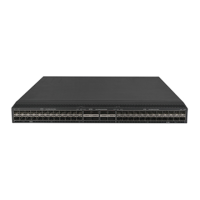28
{ Configuring the BPDU transmission rate
{ Configuring edge ports
{ Configuring path costs of ports
{ Configuring the port priority
{ Configuring the port link type
5. (Optional.) Configuring the mode a port uses to recognize and send MSTP frames
6. (Optional.) Enabling outputting port state transition information
7. Enabling the spanning tree feature
8. (Option
al.) Configuring advanced spanning tree features
{ Performing mCheck
{ Configuring Digest Snooping
{ Configuring No Agreement Check
{ Configuring TC Snooping
{ Configuring protection features
{ Disabling the device from reactivating edge ports shut down by BPDU guard
{ Enabling BPDU transparent transmission on a port
{ Enabling SNMP notifications for new-root election and topology change events
Setting the spanning tree mode
About spanning tree mode
The spanning tree modes include:
• STP mode—All ports of the device send STP BPDUs. Select this mode when the peer device
of a port supports only STP.
• RSTP mode—All ports of the device send RSTP BPDUs. A port in this mode automatically
transits to the STP mode when it receives STP BPDUs from the peer device. A port in this mode
does not transit to the MSTP mode when it receives MSTP BPDUs from the peer device.
• PVST mode—All ports of the device send PVST BPDUs. Each VLAN maintains a spanning
tree. In a network, the amount of spanning trees maintained by all devices equals the number of
PVST-enabled VLANs multiplied by the number of PVST-enabled ports. If the amount of
spanning trees exceeds the capacity of the network, device CPUs will be overloaded. Packet
forwarding is interrupted, and the network becomes unstable. The device can maintain
spanning trees for 500 VLANs.
• MSTP mode—All ports of the device send MSTP BPDUs. A port in this mode automatically
transits to the STP mode when receiving STP BPDUs from the peer device. A port in this mode
does not transit to the RSTP mode when receiving RSTP BPDUs from the peer device.
Restrictions and guidelines
The MSTP mode is compatible with the RSTP mode, and the RSTP mode is compatible with the STP
mode.
Compatibility of the PVST mode depends on the link type of a port.
• On an access port, the PVST mode is compatible with other spanning tree modes in all VLANs.
• On a trunk port or hybrid port, the PVST mode is compatible with other spanning tree modes
only in the default VLAN.
Procedure
1. Enter system view.
system-view

